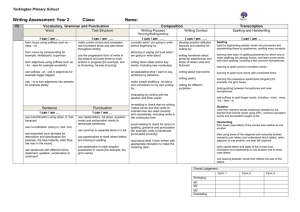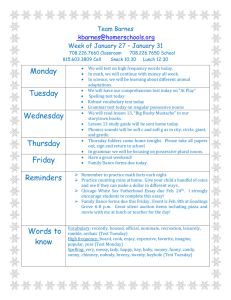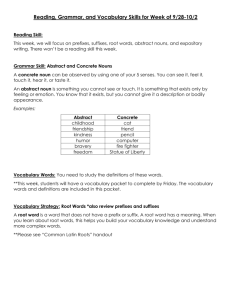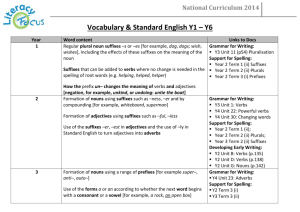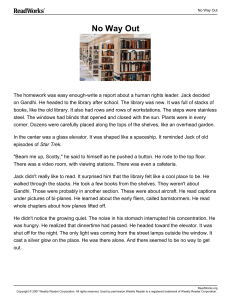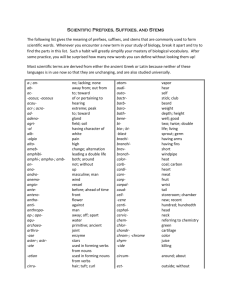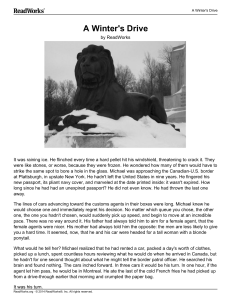Unit 1
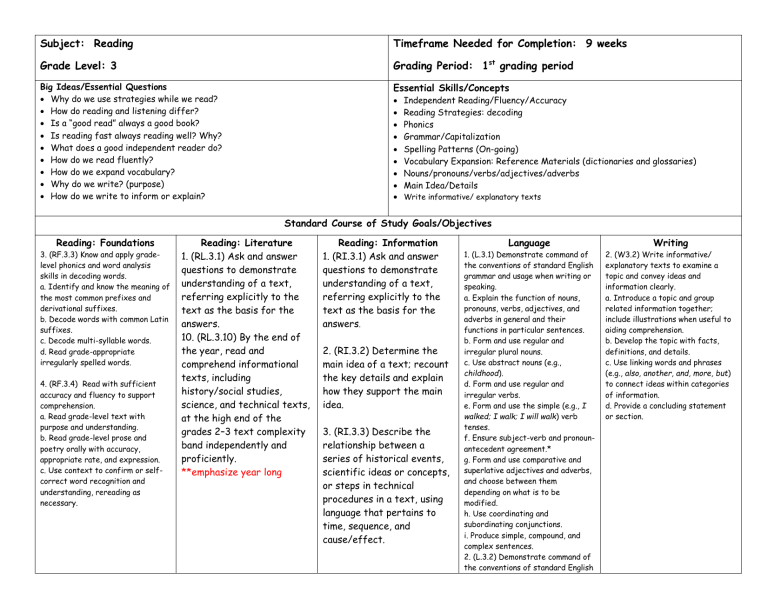
Subject: Reading
Grade Level: 3
Timeframe Needed for Completion: 9 weeks
Grading Period: 1
st
grading period
Big Ideas/Essential Questions
Why do we use strategies while we read?
How do reading and listening differ?
Is a “good read” always a good book?
Is reading fast always reading well? Why?
What does a good independent reader do?
How do we read fluently?
How do we expand vocabulary?
Why do we write? (purpose)
How do we write to inform or explain?
Reading: Foundations
3. (RF.3.3) Know and apply gradelevel phonics and word analysis skills in decoding words. a. Identify and know the meaning of the most common prefixes and derivational suffixes. b. Decode words with common Latin suffixes. c. Decode multi-syllable words. d. Read grade-appropriate irregularly spelled words.
4. (RF.3.4) Read with sufficient accuracy and fluency to support comprehension. a. Read grade-level text with purpose and understanding. b. Read grade-level prose and poetry orally with accuracy, appropriate rate, and expression. c. Use context to confirm or selfcorrect word recognition and understanding, rereading as necessary.
Reading: Literature
1. (RL.3.1) Ask and answer questions to demonstrate understanding of a text, referring explicitly to the text as the basis for the answers.
10. (RL.3.10) By the end of the year, read and comprehend informational texts, including history/social studies, science, and technical texts, at the high end of the grades 2–3 text complexity band independently and proficiently.
**emphasize year long
Essential Skills/Concepts
Independent Reading/Fluency/Accuracy
Reading Strategies: decoding
Phonics
Grammar/Capitalization
Spelling Patterns (On-going)
Vocabulary Expansion: Reference Materials (dictionaries and glossaries)
Nouns/pronouns/verbs/adjectives/adverbs
Main Idea/Details
Write informative/ explanatory texts
Standard Course of Study Goals/Objectives
Reading: Information
1. (RI.3.1) Ask and answer questions to demonstrate understanding of a text, referring explicitly to the text as the basis for the answers .
2. (RI.3.2) Determine the main idea of a text; recount the key details and explain how they support the main idea.
3. (RI.3.3) Describe the relationship between a series of historical events, scientific ideas or concepts, or steps in technical procedures in a text, using language that pertains to time, sequence, and cause/effect.
Language
1. (L.3.1) Demonstrate command of the conventions of standard English grammar and usage when writing or speaking. a. Explain the function of nouns, pronouns, verbs, adjectives, and adverbs in general and their functions in particular sentences. b. Form and use regular and irregular plural nouns. c. Use abstract nouns (e.g.,
childhood). d. Form and use regular and irregular verbs. e. Form and use the simple (e.g., I
walked; I walk; I will walk) verb tenses. f. Ensure subject-verb and pronounantecedent agreement.* g. Form and use comparative and superlative adjectives and adverbs, and choose between them depending on what is to be modified. h. Use coordinating and subordinating conjunctions. i. Produce simple, compound, and complex sentences.
2. (L.3.2) Demonstrate command of the conventions of standard English
Writing
2. (W3.2) Write informative/ explanatory texts to examine a topic and convey ideas and information clearly. a. Introduce a topic and group related information together; include illustrations when useful to aiding comprehension. b. Develop the topic with facts, definitions, and details. c. Use linking words and phrases
(e.g., also, another, and, more, but) to connect ideas within categories of information. d. Provide a concluding statement or section.
capitalization, punctuation, and spelling when writing. a. Capitalize appropriate words in titles. b. Use commas in addresses. c. Use commas and quotation marks in dialogue. d. Form and use possessives. e. Use conventional spelling for high-frequency and other studied words and for adding suffixes to base words (e.g., sitting, smiled,
cries, happiness). f. Use spelling patterns and generalizations (e.g., word families, position-based spellings, syllable patterns, ending rules, meaningful
word parts) in writing words. g. Consult reference materials, including beginning dictionaries, as needed to check and correct spellings.
3. (L.3.3) Use knowledge of language and its conventions when writing, speaking, reading, or listening. a. Choose words and phrases for effect.* b. Recognize and observe differences between the conventions of spoken and written standard English.
4. (L.3.4)Determine or clarify the meaning of unknown and multiplemeaning word and phrases based on grade 3 reading and content, choosing flexibly from a range of strategies. a. Use sentence-level context as a clue to the meaning of a word or phrase. b. Determine the meaning of the new word formed when a known affix is added to a known word
(e.g., agreeable/disagreeable, comfortable/uncomfortable, care/careless, heat/preheat). c. Use a known root word as a clue
Assessment Tasks:
Foldable projects, ClassScape, Pensieve (student conferencing), Anecdotal
Notes, Reading A to Z, edHelper.com, graphic organizers, venn diagrams,
Reading 3D
Materials Suggestions:
Daily 5 resource books, books on tape, novels, and computer web sites
(Tumblebooks Library and Learn 360), I charts, Peony
Room/proteacher.net, Leveled Books (examples include but are not limited to: Sarah, Plain and Tall, Because of Winn Dixie, Stone Fox, Cloudy with a
Chance of Meatballs, Jan Brett books, Patricia Polacco books,
ClassScape Passages for Benchmark Assessment:
QuickSilver Bob
Horace Greeley as a Boy
The Puddle Stomping Day to the meaning of an unknown word with the same root (e.g., company, companion). d. Use glossaries or beginning dictionaries, both print and digital, to determine or clarify the precise meaning of key words and phrases.
Skills On-going throughout the
year!
Integration Suggestions Social Studies:
Books on history (Jamestown, colonial times, Roanoke Island, historical figures, etc)
Integration Suggestions Science:
Books on earth/moon/sun/constellations, movement in the sky
Read Works website:
Dictionary Skills http://www.readworks.org/lessons/grade2/vocabulary-context/lesson-4
Main Idea http://www.readworks.org/lessons/grade3/main-idea/lesson-1 http://www.readworks.org/lessons/grade3/main-idea/lesson-2
Morpheme http://www.readwritethink.org/classroom-resources/lesson-plans/rooting-meaningmorpheme-match-880.html
Prefixes http://www.readworks.org/lessons/grade2/vocabulary-context/lesson-1


